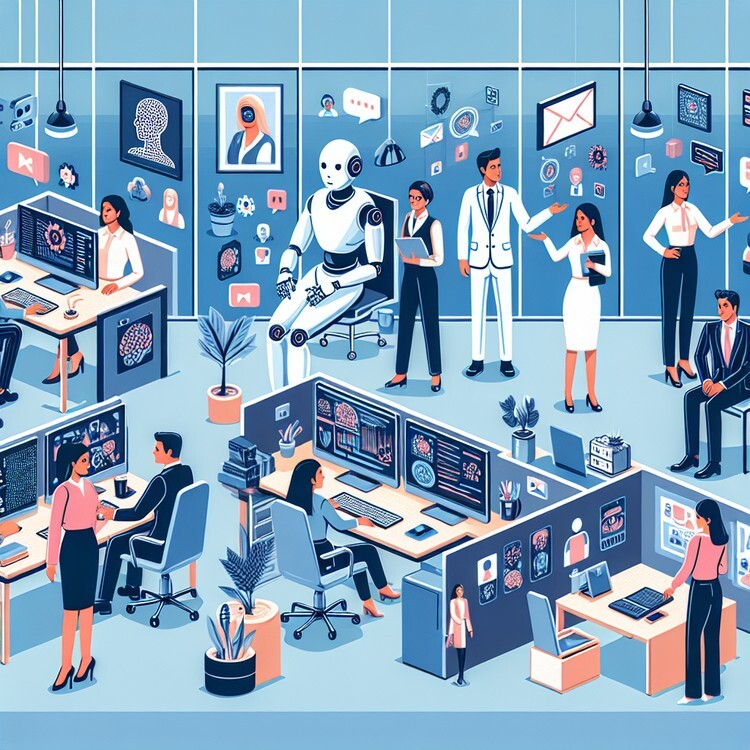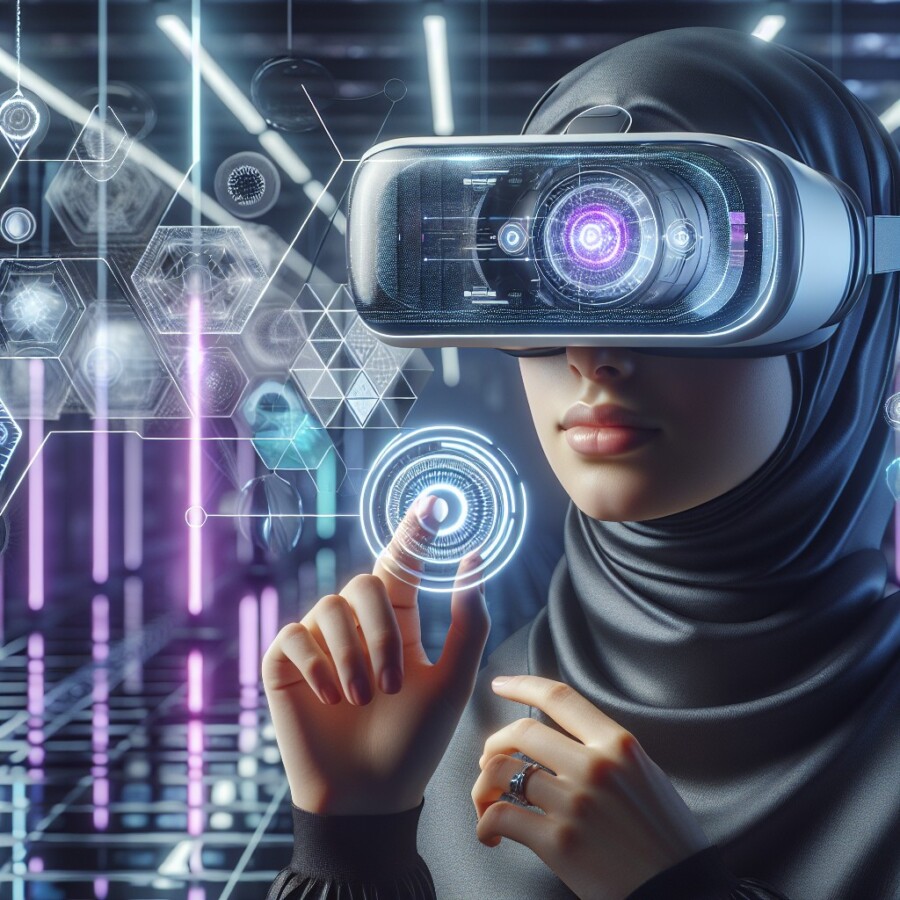Employers are looking for people who know how to use artificial intelligence (AI) in their jobs. Companies like Deel in San Francisco want employees who can use AI tools to make their work easier. For example, they might use a tool called ChatGPT to help with tasks like organizing information. More and more job postings mention AI, which shows that there is a growing demand for people who know about it. But many workers feel overwhelmed because they have to learn so much about AI.
AI can be really helpful for businesses, especially smaller ones that don’t have a lot of resources. It can help them do more work without needing more people, and it can be used for things like creating content and making software. AI tools can also help managers and staff write better performance reviews. But it’s important to find a balance between using AI and having human input. We don’t want everything to sound robotic and the same. Companies also need to be careful about legal and security issues, and not lose the unique culture and expertise of their human workers.
AI systems are only as good as the information they are based on. This means that there is a risk of copying human biases and discrimination. That’s why we should see AI as a tool to help us do our jobs better, not to replace us. Even though most workers haven’t been trained in AI by their employers, it’s still important for us to learn about it. We can try out free AI tools online and take online courses to learn more. In the end, businesses should focus on how AI can improve things, not just make them faster, and aim for a mix of human and AI workers.
Original news source: What do employers expect staff to know about AI? (BBC)
Listen:
Slow
Normal
Fast
Vocabulary:
| 1 | artificial intelligence (AI) | A type of technology that helps people do their jobs better |
| 2 | overwhelmed | Feeling stressed and unable to cope with a lot of information or tasks |
| 3 | resources | Things like money, time, and equipment that a company has available to use |
| 4 | balance | Finding the right amount of something so that it is not too much or too little |
| 5 | robotic | Acting or sounding like a machine, without any human qualities |
| 6 | legal | Related to the law and following the rules |
| 7 | security | Keeping something safe and protected from harm or danger |
| 8 | expertise | Special knowledge or skills in a particular area |
| 9 | biases | Unfair opinions or preferences that people have, without knowing all the facts |
| 10 | discrimination | Treating people unfairly because of their race, gender, or other characteristics |
| 11 | trained | Taught or educated in a particular skill or subject |
| 12 | improve | Making something better or more effective |
| 13 | mix | A combination of different things or people |
| 14 | demand | The amount of people who want or need something |
| 15 | unique | Being one of a kind and not like anything else |
Group or Classroom Activities
Warm-up Activities:
– Charades
Instructions: Divide the class into two teams. Give each team a list of AI-related words or phrases from the article. One person from each team will act out the word or phrase without speaking, while their team tries to guess what it is. The team with the most correct guesses wins.
– News Summary
Instructions: In pairs, students will take turns summarizing the main points of the article to their partner. They should try to include the key information and use their own words. After both partners have had a chance to share, they can compare their summaries and discuss any differences.
– Opinion Poll
Instructions: Write a set of opinion questions related to the article, such as “Do you think AI will replace human workers in the future?” or “How comfortable are you using AI tools?” Have students walk around the classroom and ask their classmates the questions, recording their responses. Afterward, students can share their findings and discuss the different opinions.
– Vocabulary Pictionary
Instructions: Divide the class into small groups. Give each group a list of AI-related vocabulary words from the article. One person from each group will choose a word and draw a picture representing that word, while their group tries to guess what it is. The group with the most correct guesses wins.
– Future Predictions
Instructions: In pairs, students will take turns making predictions about the future of AI in the workplace. They should base their predictions on the information from the article and their own opinions. After both partners have made their predictions, they can discuss and compare their ideas.
Comprehension Questions:
1. Why are employers interested in hiring people who know how to use artificial intelligence (AI)?
2. How can AI tools benefit smaller businesses?
3. What is the risk of AI systems copying human biases and discrimination?
4. Why is it important for workers to learn about AI, even if their employers haven’t trained them?
5. How can individuals learn more about AI?
6. What should businesses focus on when using AI?
7. Why is it important to find a balance between using AI and human input?
8. What are some potential legal and security issues that companies need to be careful about when using AI?
Go to answers ⇩
Listen and Fill in the Gaps:
Employers are looking for people who know how to use (1)______ intelligence (AI) in their jobs. Companies like Deel in San (2)______ want (3)______ who can use AI tools to make their work (4)______. For example, they might use a tool called ChatGPT to help with tasks like organizing information. More and more job postings mention AI, which shows that there is a growing demand for people who know about it. But many workers feel overwhelmed because they have to learn so much about AI.
AI can be really helpful for businesses, especially smaller ones that don’t have a lot of resources. It can help them do more work without needing more people, and it can be used for things like creating content and making software. AI (5)______ can also help (6)______ and (7)______ write (8)______ performance reviews. But it’s important to find a (9)______ between (10)______ AI and having human input. We don’t want everything to sound robotic and the same. Companies also need to be (11)______ about (12)______ and security issues, and not lose the unique culture and expertise of their human workers.
AI systems are only as good as the information they are based on. This means that there is a risk of copying human biases and discrimination. That’s why we should see AI as a tool to help us do our jobs better, not to (13)______ us. Even though most workers haven’t been trained in AI by their employers, it’s still (14)______ for us to learn about it. We can try out free AI tools (15)______ and take online courses to learn more. In the end, businesses should focus on how AI can improve things, not just make them faster, and aim for a mix of (16)______ and AI workers.
Go to answers ⇩
Discussion Questions:
Students can ask a partner these questions, or discuss them as a group.
1. What is artificial intelligence (AI) and how do you think it is used in businesses?
2. How would you feel if your job required you to learn about and use AI tools? Why?
3. Do you think AI is a good tool for businesses? Why or why not?
4. What are some advantages of using AI in the workplace? Can you think of any disadvantages?
5. How do you think AI can be used to improve performance reviews? Why or why not?
6. Do you think AI could replace human workers in the future? Why or why not?
7. Have you ever used any AI tools? If yes, how was your experience? If no, would you like to try using them? Why or why not?
8. How do you think AI can help smaller businesses with limited resources? Why is this important?
9. What do you think are some risks or challenges of using AI in the workplace? Why?
10. How do you think AI can help businesses improve their work, aside from making it faster? Why is this important?
11. Do you think it’s important for workers to learn about AI, even if their employers don’t provide training? Why or why not?
12. Have you ever taken an online course to learn about a new topic? If yes, how was your experience? If no, would you like to try it? Why or why not?
13. How do you think AI can help businesses maintain their unique culture and expertise? Why is this important?
14. Do you think AI can have biases or discrimination? Why or why not? How can this be avoided?
15. In your opinion, what is the ideal balance between human and AI workers in a company? Why?
Individual Activities
Vocabulary Meanings:
Match each word to its meaning.
Words:
1. artificial intelligence (AI)
2. overwhelmed
3. resources
4. balance
5. robotic
6. legal
7. security
8. expertise
9. biases
10. discrimination
11. trained
12. improve
13. mix
14. demand
15. unique
Meanings:
(A) Unfair opinions or preferences that people have, without knowing all the facts
(B) Treating people unfairly because of their race, gender, or other characteristics
(C) Feeling stressed and unable to cope with a lot of information or tasks
(D) Taught or educated in a particular skill or subject
(E) Being one of a kind and not like anything else
(F) Finding the right amount of something so that it is not too much or too little
(G) Keeping something safe and protected from harm or danger
(H) A type of technology that helps people do their jobs better
(I) Making something better or more effective
(J) Special knowledge or skills in a particular area
(K) Acting or sounding like a machine, without any human qualities
(L) A combination of different things or people
(M) The amount of people who want or need something
(N) Related to the law and following the rules
(O) Things like money, time, and equipment that a company has available to use
Go to answers ⇩
Multiple Choice Questions:
1. Why are employers looking for people who know how to use AI in their jobs?
(a) AI tools are expensive
(b) AI tools are not effective
(c) AI tools are not in demand
(d) AI tools can make work easier
2. What is one way AI can help businesses?
(a) By replacing human workers
(b) By increasing costs for businesses
(c) By decreasing productivity
(d) By allowing them to do more work without needing more people
3. What is one potential risk of using AI systems?
(a) Making work more difficult
(b) Copying human biases and discrimination
(c) Increasing the need for human workers
(d) Decreasing work efficiency
4. How can workers learn about AI?
(a) By trying out free AI tools online and taking online courses
(b) By relying on their employers to train them
(c) By avoiding AI altogether
(d) By attending in-person workshops
5. What should businesses focus on when using AI?
(a) How AI can replace human workers completely
(b) How AI can improve things, not just make them faster
(c) How AI can decrease costs for the company
(d) How AI can increase the workload for employees
6. What is one concern about using AI in the workplace?
(a) AI tools being too expensive for smaller businesses
(b) AI tools not being effective in improving work processes
(c) Losing the unique culture and expertise of human workers
(d) AI tools causing legal and security issues
7. Why do many workers feel overwhelmed by the need to learn about AI?
(a) Because AI tools are not in demand
(b) Because AI tools are too expensive
(c) Because they have to learn so much about it
(d) Because AI tools are not effective
8. What is one example of an AI tool mentioned in the article?
(a) ChatGPT
(b) ChatBot
(c) ChatAI
(d) ChatAI-GPT
Go to answers ⇩
True or False Questions:
1. AI systems can be influenced by human biases and discrimination if not based on reliable information.
2. Companies like Deel in San Francisco want employees who can use AI tools to make their work easier.
3. AI is not beneficial for businesses, particularly smaller ones with limited resources.
4. It’s not important to strike a balance between using AI and incorporating human input to avoid sounding robotic and losing unique human expertise.
5. AI tools cannot help with tasks like organizing information, creating content, and making software.
6. Businesses should not focus on how AI can improve things, rather than solely on making processes faster, and should not aim for a combination of human and AI workers.
7. Workers should take the initiative to learn about AI, even if their employers haven’t provided training.
8. Job postings are increasingly mentioning AI, indicating a growing demand for people with AI knowledge.
Go to answers ⇩
Write a Summary:
Write a summary of this news article in two sentences.
Check your writing now with the best free AI for English writing!
Writing Questions:
Answer the following questions. Write as much as you can for each answer.
Check your answers with our free English writing assistant!
1. Why do employers want employees who know how to use artificial intelligence (AI)?
2. How can AI tools help businesses, especially smaller ones?
3. What is the risk of using AI systems?
4. Why is it important for workers to learn about AI, even if their employers haven’t trained them?
5. What should businesses focus on when using AI in their operations?
Answers
Comprehension Question Answers:
1. Why are employers interested in hiring people who know how to use artificial intelligence (AI)?
Employers are interested in hiring people who know how to use AI because it can make their work easier and more efficient. AI tools can help with tasks like organizing information and creating content, which can save time and resources for businesses.
2. How can AI tools benefit smaller businesses?
AI tools can benefit smaller businesses by allowing them to do more work without needing to hire more people. This can help them save money and compete with larger companies. AI can also be used for tasks like making software and improving performance reviews, which can help smaller businesses improve their operations.
3. What is the risk of AI systems copying human biases and discrimination?
The risk of AI systems copying human biases and discrimination is that they can perpetuate unfair practices and discrimination. AI systems are only as good as the information they are based on, so if the data they use contains biases or discrimination, the AI system may also exhibit those biases. This can lead to unfair outcomes and perpetuate inequality.
4. Why is it important for workers to learn about AI, even if their employers haven’t trained them?
It is important for workers to learn about AI, even if their employers haven’t trained them, because AI is becoming increasingly prevalent in many industries. By learning about AI, workers can stay relevant and competitive in the job market. They can also better understand how AI is being used in their field and how it can benefit their work.
5. How can individuals learn more about AI?
Individuals can learn more about AI by trying out free AI tools online and taking online courses. There are many resources available that can help individuals learn the basics of AI and how it is being used in different industries. Additionally, individuals can attend workshops and seminars on AI to gain more in-depth knowledge.
6. What should businesses focus on when using AI?
When using AI, businesses should focus on how it can improve things, not just make them faster. They should consider how AI can enhance their operations, improve efficiency, and provide better outcomes. It is also important for businesses to maintain a balance between using AI and human input, to ensure that the unique culture and expertise of human workers are not lost.
7. Why is it important to find a balance between using AI and human input?
It is important to find a balance between using AI and human input because AI systems are not perfect and can have limitations. Human input is necessary to provide context, creativity, and critical thinking that AI may lack. Additionally, relying solely on AI can lead to a lack of diversity and a loss of human connection in the workplace.
8. What are some potential legal and security issues that companies need to be careful about when using AI?
Some potential legal and security issues that companies need to be careful about when using AI include data privacy and protection. AI systems often require access to large amounts of data, and companies need to ensure that this data is handled securely and in compliance with regulations. There is also a risk of AI systems making biased or discriminatory decisions, which can lead to legal issues. Companies need to be mindful of these risks and take steps to mitigate them.
Go back to questions ⇧
Listen and Fill in the Gaps Answers:
(1) artificial
(2) Francisco
(3) employees
(4) easier
(5) tools
(6) managers
(7) staff
(8) better
(9) balance
(10) using
(11) careful
(12) legal
(13) replace
(14) important
(15) online
(16) human
Go back to questions ⇧
Vocabulary Meanings Answers:
1. artificial intelligence (AI)
Answer: (H) A type of technology that helps people do their jobs better
2. overwhelmed
Answer: (C) Feeling stressed and unable to cope with a lot of information or tasks
3. resources
Answer: (O) Things like money, time, and equipment that a company has available to use
4. balance
Answer: (F) Finding the right amount of something so that it is not too much or too little
5. robotic
Answer: (K) Acting or sounding like a machine, without any human qualities
6. legal
Answer: (N) Related to the law and following the rules
7. security
Answer: (G) Keeping something safe and protected from harm or danger
8. expertise
Answer: (J) Special knowledge or skills in a particular area
9. biases
Answer: (A) Unfair opinions or preferences that people have, without knowing all the facts
10. discrimination
Answer: (B) Treating people unfairly because of their race, gender, or other characteristics
11. trained
Answer: (D) Taught or educated in a particular skill or subject
12. improve
Answer: (I) Making something better or more effective
13. mix
Answer: (L) A combination of different things or people
14. demand
Answer: (M) The amount of people who want or need something
15. unique
Answer: (E) Being one of a kind and not like anything else
Go back to questions ⇧
Multiple Choice Answers:
1. Why are employers looking for people who know how to use AI in their jobs?
Answer: (d) AI tools can make work easier
2. What is one way AI can help businesses?
Answer: (d) By allowing them to do more work without needing more people
3. What is one potential risk of using AI systems?
Answer: (b) Copying human biases and discrimination
4. How can workers learn about AI?
Answer: (a) By trying out free AI tools online and taking online courses
5. What should businesses focus on when using AI?
Answer: (b) How AI can improve things, not just make them faster
6. What is one concern about using AI in the workplace?
Answer: (c) Losing the unique culture and expertise of human workers
7. Why do many workers feel overwhelmed by the need to learn about AI?
Answer: (c) Because they have to learn so much about it
8. What is one example of an AI tool mentioned in the article?
Answer: (a) ChatGPT
Go back to questions ⇧
True or False Answers:
1. AI systems can be influenced by human biases and discrimination if not based on reliable information. (Answer: True)
2. Companies like Deel in San Francisco want employees who can use AI tools to make their work easier. (Answer: True)
3. AI is not beneficial for businesses, particularly smaller ones with limited resources. (Answer: False)
4. It’s not important to strike a balance between using AI and incorporating human input to avoid sounding robotic and losing unique human expertise. (Answer: False)
5. AI tools cannot help with tasks like organizing information, creating content, and making software. (Answer: False)
6. Businesses should not focus on how AI can improve things, rather than solely on making processes faster, and should not aim for a combination of human and AI workers. (Answer: False)
7. Workers should take the initiative to learn about AI, even if their employers haven’t provided training. (Answer: True)
8. Job postings are increasingly mentioning AI, indicating a growing demand for people with AI knowledge. (Answer: True)
Go back to questions ⇧













